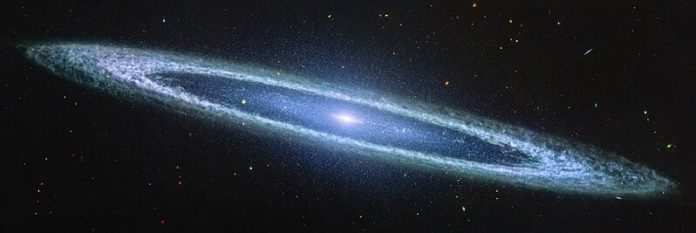In the new mid-infrared image taken by the James Webb Space Telescope, the Sombrero galaxy (technically known as Messier 104 or M104 galaxy) appears more like an archery target, instead of wide-brimmed Mexican hat Sombrero as it appeared in earlier visible light images taken by Spitzer and Hubble space telescopes.
Recent image of Messier 104 (M104) galaxy (known popularly as Sombrero galaxy due to its resembleness to the wide-brimmed Mexican hat) taken by the Mid-Infrared Instrument (MIRI) of James Webb Space Telescope (JWST) has provided new insight into structural details of its outer ring and the core.
In the new infrared image, the core does not shine, Instead, we see a smooth inner disk. The nature of the dust along the outer ring is much resolved in the new image and intricate clumps are seen for the first time. This contrasts with the visible light images taken earlier by Spitzer and Hubble telescopes wherein the glowing core of the galaxy shines and the outer ring appears smooth like a blanket.
In the new image in the mid-infrared range, the galaxy appears more like an archery target, instead of wide-brimmed Mexican hat Sombrero as was seen in earlier visible light images.
Using MIRI data, the researchers detected polycyclic aromatic hydrocarbons in the dust clumps along the outer ring of Sombrero galaxy. Presence of carbon (i.e., high metallicity) suggests presence of young star-formation regions in the outer ring, however this is not supported by observations. The supermassive black hole at the centre of galaxy is a low luminosity active galactic nucleus.
| The first stars in the universe have zero-metal or extremely low-metal. They are called Pop III stars or Population III stars. Low metal stars are Pop II stars. Young stars have high metal contents and are called “Pop I stars” or the solar metal stars. With a relatively high 1.4% metallicity, sun is a recent star. In astronomy, any element heavier than helium is considered a metal. Chemical non-metals like oxygen, nitrogen etc are metals in cosmological context. Stars get metal enriched in each generation following supernova event. Increasing metal content in stars indicates younger age. |
| (an excerpt from Early Universe: The Most Distant Galaxy “JADES-GS-z14-0″ Challenges Galaxy Formation Models , Scientific European). |
The outer region of a galaxy is typically made of older, metal-poor stars. However, Hubble’s metallicity measurements (i.e., the abundance of elements heavier than helium in the stars) conducted earlier indicated abundance of metal-rich stars in the vast halo of Sombrero galaxy suggesting generations of stars may have undergone turbulent supernovae events in the outer region of this galaxy. Usually, halo of galaxies has metal-poor stars, but the halo of Sombrero galaxy barely show any sign of the expected metal-poor stars. Paradoxically, it has metal-rich stars.
The Sombrero galaxy is a spiral galaxy situated 28 million light-years away from Earth in the constellation Virgo. Not visible to the naked eye, it was discovered in 1781 by the French astronomer Pierre Méchain.
***
References:
- NASA. News – Hats Off to NASA’s Webb: Sombrero Galaxy Dazzles in New Image. Posted 25 November 2024. Available at https://science.nasa.gov/missions/webb/hats-off-to-nasas-webb-sombrero-galaxy-dazzles-in-new-image/
- NASA. Beyond the Brim, Sombrero Galaxy’s Halo Suggests Turbulent Past. Posted 20 February 2020. Available at https://science.nasa.gov/missions/hubble/beyond-the-brim-sombrero-galaxys-halo-suggests-turbulent-past/
- NASA. Messier 104. Available at https://science.nasa.gov/mission/hubble/science/explore-the-night-sky/hubble-messier-catalog/messier-104/
***




































